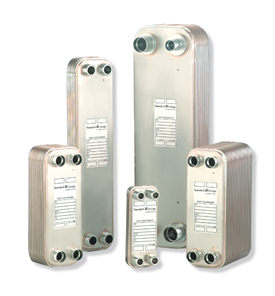In the realm of heat exchangers, brazed plate heat exchangers have emerged as a revolutionary technology, transforming the landscape of heat transfer efficiency. In this blog, we delve into the intricacies of brazed plate heat exchangers, exploring their design, advantages, and applications. Additionally, we will touch upon the comparison with another popular heat exchanger type – the double pipe heat exchanger.
Understanding Brazed Plate Heat Exchangers
Brazed plate heat exchangers revolutionize heat transfer with a compact, efficient design. Comprising corrugated metal plates brazed together, they enhance fluid turbulence, optimizing thermal performance. The absence of traditional gaskets ensures durability, making them a versatile and reliable solution for diverse applications across industries.
What are Brazed Plate Heat Exchangers?
Brazed plate heat exchangers are compact, high-performance devices designed for efficient heat transfer between two fluids. Their construction typically involves layers of corrugated metal plates that are brazed together. The brazing process not only ensures a strong bond between plates but also eliminates the need for traditional gaskets, enhancing the unit’s durability and reliability.
Design and Functionality
The corrugated design of the plates in brazed plate heat exchangers plays a pivotal role in optimizing heat transfer. This configuration creates turbulence in the fluid flow, promoting better heat exchange between the fluids. The compact design ensures a high surface area-to-volume ratio, resulting in a more efficient and space-saving solution compared to traditional heat exchangers.
Advantages of Brazed Plate Heat Exchangers
Brazed plate heat exchangers offer unmatched advantages. Their compact design enhances energy efficiency, providing a high surface area-to-volume ratio for optimal heat transfer. The absence of gaskets ensures durability and reliability, making them versatile for various applications. This efficiency, coupled with a compact footprint, defines them as a superior heat exchange solution.
1. Efficiency Boost
The unique design of brazed plate heat exchangers facilitates efficient heat transfer, leading to improved energy efficiency. The turbulent flow created by the corrugated plates enhances thermal performance, allowing for rapid and effective heat exchange.
2. Compact Footprint
Unlike conventional heat exchangers, brazed plate heat exchangers are known for their compact size. This space-saving design makes them ideal for installations where space is a premium, providing flexibility in system layouts and configurations.
3. Durability and Reliability
The brazing process used in their construction eliminates the need for gaskets, reducing the risk of leakage and enhancing overall durability. This robust construction ensures a reliable and long-lasting heat exchange solution for various applications.
4. Versatility in Applications
Brazed plate heat exchangers find applications across a wide range of industries, including HVAC systems, refrigeration, industrial processes, and renewable energy systems. Their adaptability to different working conditions makes them a versatile choice for various heat transfer needs.
Comparing Brazed Plate Heat Exchangers with Double Pipe Heat Exchangers
Comparing Brazed Plate Heat Exchangers with Double Pipe Heat Exchangers reveals distinct differences. Brazed plates excel in compactness, offering efficient heat transfer with a smaller footprint. The corrugated design boosts turbulence, enhancing performance. While double pipe exchangers are effective, the space efficiency and adaptability of brazed plates make them a superior choice for many applications.
1. Size and Space Requirements
Brazed plate heat exchangers excel in terms of compactness, offering a smaller footprint compared to double pipe heat exchangers. This advantage makes them particularly suitable for installations with limited space.
2. Heat Transfer Efficiency
The corrugated plate design of brazed plate heat exchangers promotes turbulent flow, significantly enhancing heat transfer efficiency. While double pipe heat exchangers are also effective, they may require more space to achieve comparable performance.
3. Construction and Maintenance
Brazed plate heat exchangers, with their brazed construction, eliminate the need for gaskets, simplifying maintenance and reducing the risk of leaks. Double pipe heat exchangers, with their simpler design, may be easier to clean but could be more prone to maintenance issues associated with gaskets.
Conclusion
In conclusion, brazed plate heat exchangers stand as a testament to innovation in heat transfer technology. Their compact design, efficiency, and versatility make them a preferred choice across diverse industries. Understanding the advantages of brazed plate heat exchangers, especially in comparison to double pipe heat exchangers, can guide engineers and system designers in selecting the most suitable solution for their specific applications. As the demand for energy-efficient and space-saving heat transfer solutions continues to rise, brazed plate heat exchangers are poised to play a crucial role in shaping the future of thermal management systems.

